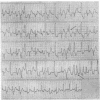Full text
PDF








Images in this article
Selected References
These references are in PubMed. This may not be the complete list of references from this article.
- BROWN K. W., MACMILLAN R. L., FORBATH N., MELGRANO F., SCOTT J. W. CORONARY UNIT: AN INTENSIVE-CARE CENTRE FOR ACUTE MYOCARDIAL INFARCTION. Lancet. 1963 Aug 17;2(7303):349–352. doi: 10.1016/s0140-6736(63)93011-3. [DOI] [PubMed] [Google Scholar]
- Carroll S. E., Ahuja S. P., Manning G. W. The initiation of ventricular tachycardia and fibrillation in experimental coronary artery occlusion. Am J Cardiol. 1965 Dec;16(6):813–819. doi: 10.1016/0002-9149(65)90698-3. [DOI] [PubMed] [Google Scholar]
- Dolara A. Early premature ventricular beats, repetitive ventricular response, and ventricular fibrillation. Am Heart J. 1967 Sep;74(3):332–336. doi: 10.1016/0002-8703(67)90072-5. [DOI] [PubMed] [Google Scholar]
- FASTIER F. N. Electrocardiographic features of adrenaline syncope. J Physiol. 1951 Feb;112(3-4):359–366. doi: 10.1113/jphysiol.1951.sp004534. [DOI] [PMC free article] [PubMed] [Google Scholar]
- Fastier F. N., Smirk F. H. Some properties of amarin, with special reference to its use in conjunction with adrenaline for the production of idio-ventricular rhythms. J Physiol. 1948 Jun 25;107(3):318–331. doi: 10.1113/jphysiol.1948.sp004276. [DOI] [PMC free article] [PubMed] [Google Scholar]
- Gutierrez M. R., Changfoot G. H., Peretz D. I. Significance of T wave interruption by premature beats as a cause of sudden death. Can Med Assoc J. 1968 Jan 20;98(3):144–149. [PMC free article] [PubMed] [Google Scholar]
- JULIAN D. G., VALENTINE P. A., MILLER G. G. DISTURBANCES OF RATE, RHYTHM AND CONDUCTION IN ACUTE MYOCARDIAL INFARCTION: A PROSPECTIVE STUDY OF 100 CONSECUTIVE UNSELECTED PATIENTS WITH THE AID OF ELECTROCARDIOGRAPHIC MONITORING. Am J Med. 1964 Dec;37:915–927. doi: 10.1016/0002-9343(64)90133-0. [DOI] [PubMed] [Google Scholar]
- Lawrie D. M., Greenwood T. W., Goddard M., Harvey A. C., Donald K. W., Julian D. G., Oliver M. F. A coronary-care unit in the routine management of acute myocardial infarction. Lancet. 1967 Jul 15;2(7507):109–114. doi: 10.1016/s0140-6736(67)92959-5. [DOI] [PubMed] [Google Scholar]
- Lown B., Fakhro A. M., Hood W. B., Jr, Thorn G. W. The coronary care unit. New perspectives and directions. JAMA. 1967 Jan 16;199(3):188–198. [PubMed] [Google Scholar]
- MOORE J. I., SWAIN H. H. Sensitization to ventricular fibrillation. I Sensitization by a substituted propiophenone, U-0882. J Pharmacol Exp Ther. 1960 Mar;128:243–252. [PubMed] [Google Scholar]
- Ng J. Interruption of T waves by intrinsic QRS complexes. N Z Med J. 1968 Mar;67(429):361–373. [PubMed] [Google Scholar]
- PALMER D. G. Interruption of T waves by premature QRS complexes and the relationship of this phenomenon to ventricular fibrillation. Am Heart J. 1962 Mar;63:367–373. doi: 10.1016/0002-8703(62)90281-8. [DOI] [PubMed] [Google Scholar]
- PRESTON J. B., McFADDEN S., MOE G. K. Atrioventricular transmission in young mammals. Am J Physiol. 1959 Jul;197(1):236–240. doi: 10.1152/ajplegacy.1959.197.1.236. [DOI] [PubMed] [Google Scholar]
- Parkinson J., Papp C. REPETITIVE PAROXYSMAL TACHYCARDIA. Br Heart J. 1947 Oct;9(4):241–262. doi: 10.1136/hrt.9.4.241. [DOI] [PMC free article] [PubMed] [Google Scholar]
- Restieaux N., Bray C., Bullard H., Murray M., Robinson J., Brigden W., McDonald L. 150 Patients with cardiac infarction treated in a coronary unit. Lancet. 1967 Jun 17;1(7503):1285–1289. doi: 10.1016/s0140-6736(67)91589-9. [DOI] [PubMed] [Google Scholar]
- SCHMIDT W. Kammer-Extrasystolen äusserster Vorzeitigkeit als Vorläufer Morgagni-Adams-Stokesscher Anfälle. Z Kreislaufforsch. 1952 Aug;41(15-16):590–597. [PubMed] [Google Scholar]
- SMIRK F. H., NOLLA-PANADES J., WALLIS T. EXPERIMENTAL VENTRICULAR FLUTTER AND VENTRICULAR PAROXYSMAL TACHYCARDIA. Am J Cardiol. 1964 Jul;14:79–88. doi: 10.1016/0002-9149(64)90110-9. [DOI] [PubMed] [Google Scholar]
- SMIRK F. H., PALMER D. G. A myocardial syndrome. With particular reference to the occurrence of sudden death and of premature systoles interrupting antecedent T waves. Am J Cardiol. 1960 Sep;6:620–629. doi: 10.1016/0002-9149(60)90265-4. [DOI] [PubMed] [Google Scholar]
- SOWTON E., LEATHAM A., CARSON P. THE SUPPRESSION OF ARRHYTHMIAS BY ARTIFICIAL PACEMAKING. Lancet. 1964 Nov 21;2(7369):1098–1100. doi: 10.1016/s0140-6736(64)92615-7. [DOI] [PubMed] [Google Scholar]
- SOWTON E. THE USE OF ARTIFICIAL PACEMAKING IN CARDIAC RESUSCITATION. Proc R Soc Med. 1964 May;57:368–372. doi: 10.1177/003591576405700513. [DOI] [PMC free article] [PubMed] [Google Scholar]
- STOCK J. P. Repetitive paroxysmal ventricular tachycardia. Br Heart J. 1962 May;24:297–312. doi: 10.1136/hrt.24.3.297. [DOI] [PMC free article] [PubMed] [Google Scholar]
- Wallis A. T., Meek A. P., Ng J. Clinical and experimental applications of a central recording system. N Z Med J. 1968 Mar;67(429):356–361. [PubMed] [Google Scholar]









